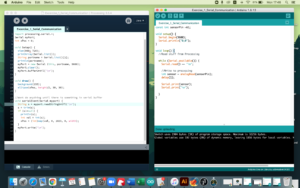Exercise 1:
Excercise 2
Exercise 3:
const int ledPin = 11;
int brightness = 0;
const int sensorPin = A0;
void setup() {
Serial.begin(9600);
Serial.println("0,0");
pinMode(ledPin, OUTPUT);
}
void loop() {
while (Serial.available()) {
int onOff = Serial.parseInt();
if (Serial.read() == '\n') {
digitalWrite(ledPin, onOff);
int sensor = analogRead(sensorPin);
delay(1);
Serial.println(sensor);
}
}
}
//PROCESSING CODE
velocity.mult(drag);
position.add(velocity);
acceleration.mult(0);
ellipse(position.x,position.y,mass,mass);
fill(255,255,0);
if (position.y > height-mass/2) {
velocity.y *= -0.9; // A little dampening when hitting the bottom
position.y = height-mass/2;
onOff = true;
}
else{
onOff = false;
}
}
void serialEvent(Serial myPort){
String s=myPort.readStringUntil('\n');
s=trim(s);
int val = parseInt(s);
if (s!=null){
wind.x=map(val,0,1023,-2, 2); //2 instead of 1 to make it stronger
}
myPort.write(int(onOff)+"\n");
}
void applyForce(PVector force){
// Newton's 2nd law: F = M * A
// or A = F / M
PVector f = PVector.div(force, mass);
acceleration.add(f);
}
void keyPressed(){
if (keyCode==LEFT){
wind.x=-1;
}
if (keyCode==RIGHT){
wind.x=1;
}
if (key==' '){
mass=random(15,80);
position.y=-mass;
velocity.mult(0);
}
}
Video for exercise 3:


